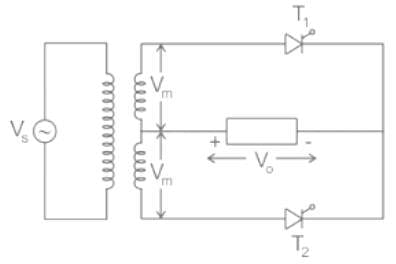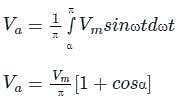Electrical Engineering (EE) Exam > Electrical Engineering (EE) Questions > A single-phase mid-point full-wave SCR conver...
Start Learning for Free
A single-phase mid-point full-wave SCR converter with maximum mid-point voltage of Vm volts develops an average output voltage across a resistive load at firing delay angles of 0 and π/2 rad., respectively, as
- a)2Vm/π,Vm/π
- b)Vm/π,Vm/2π
- c)Vm/2π, Vm/π
- d)Vm/π, −Vm/2π
Correct answer is option 'A'. Can you explain this answer?
| FREE This question is part of | Download PDF Attempt this Test |
Most Upvoted Answer
A single-phase mid-point full-wave SCR converter with maximum mid-poin...
A single-phase mid-point full-wave SCR converter:
In this circuit, two thyristors are used and are connected as shown below

Where,
Vs is the source voltage
Vm is the maximum voltage of the midpoint
Let α be the firing angle
V0 is the output voltage
When the thyristors are triggered with a firing angle 0 and π/2
Then the output waveform will be as follows


Let the average output voltage of the circuit be Va
The value of source voltage is Vm sin ωt

Calculation:

Calculation:
Given,
α1 = 0, α2 = π/2
For the first thyristor, the average output voltage is

Va = 2Vm / π

Va = 2Vm / π
For the second thyristor, the average output voltage is

Va = Vm / π

Va = Vm / π
Free Test
FREE
| Start Free Test |
Community Answer
A single-phase mid-point full-wave SCR converter with maximum mid-poin...
Explanation:
Given:
Single-phase mid-point full-wave SCR converter
Maximum mid-point voltage: Vm volts
Firing delay angles: 0 and π/2 rad
Output Voltage Calculation:
- The average output voltage for a single-phase mid-point full-wave SCR converter can be calculated using the formula:
Vavg = (2Vm/π) * (1 - cos(α))
where Vavg is the average output voltage and α is the firing delay angle.
At firing delay angle 0:
Vavg = (2Vm/π) * (1 - cos(0))
Vavg = (2Vm/π) * (1 - 1)
Vavg = (2Vm/π) * 0
Vavg = 0
At firing delay angle π/2:
Vavg = (2Vm/π) * (1 - cos(π/2))
Vavg = (2Vm/π) * (1 - 0)
Vavg = (2Vm/π)
Conclusion:
Therefore, the average output voltage across a resistive load at firing delay angles of 0 and π/2 rad is 0 and 2Vm/π volts, respectively. Hence, option 'A' is the correct answer.
Given:
Single-phase mid-point full-wave SCR converter
Maximum mid-point voltage: Vm volts
Firing delay angles: 0 and π/2 rad
Output Voltage Calculation:
- The average output voltage for a single-phase mid-point full-wave SCR converter can be calculated using the formula:
Vavg = (2Vm/π) * (1 - cos(α))
where Vavg is the average output voltage and α is the firing delay angle.
At firing delay angle 0:
Vavg = (2Vm/π) * (1 - cos(0))
Vavg = (2Vm/π) * (1 - 1)
Vavg = (2Vm/π) * 0
Vavg = 0
At firing delay angle π/2:
Vavg = (2Vm/π) * (1 - cos(π/2))
Vavg = (2Vm/π) * (1 - 0)
Vavg = (2Vm/π)
Conclusion:
Therefore, the average output voltage across a resistive load at firing delay angles of 0 and π/2 rad is 0 and 2Vm/π volts, respectively. Hence, option 'A' is the correct answer.
Attention Electrical Engineering (EE) Students!
To make sure you are not studying endlessly, EduRev has designed Electrical Engineering (EE) study material, with Structured Courses, Videos, & Test Series. Plus get personalized analysis, doubt solving and improvement plans to achieve a great score in Electrical Engineering (EE).

|
Explore Courses for Electrical Engineering (EE) exam
|

|
Similar Electrical Engineering (EE) Doubts
A single-phase mid-point full-wave SCR converter with maximum mid-point voltage of Vm volts develops an average output voltage across a resistive load at firing delay angles of 0 and π/2 rad., respectively, asa)2Vm/π,Vm/πb)Vm/π,Vm/2πc)Vm/2π, Vm/πd)Vm/π, −Vm/2πCorrect answer is option 'A'. Can you explain this answer?
Question Description
A single-phase mid-point full-wave SCR converter with maximum mid-point voltage of Vm volts develops an average output voltage across a resistive load at firing delay angles of 0 and π/2 rad., respectively, asa)2Vm/π,Vm/πb)Vm/π,Vm/2πc)Vm/2π, Vm/πd)Vm/π, −Vm/2πCorrect answer is option 'A'. Can you explain this answer? for Electrical Engineering (EE) 2024 is part of Electrical Engineering (EE) preparation. The Question and answers have been prepared according to the Electrical Engineering (EE) exam syllabus. Information about A single-phase mid-point full-wave SCR converter with maximum mid-point voltage of Vm volts develops an average output voltage across a resistive load at firing delay angles of 0 and π/2 rad., respectively, asa)2Vm/π,Vm/πb)Vm/π,Vm/2πc)Vm/2π, Vm/πd)Vm/π, −Vm/2πCorrect answer is option 'A'. Can you explain this answer? covers all topics & solutions for Electrical Engineering (EE) 2024 Exam. Find important definitions, questions, meanings, examples, exercises and tests below for A single-phase mid-point full-wave SCR converter with maximum mid-point voltage of Vm volts develops an average output voltage across a resistive load at firing delay angles of 0 and π/2 rad., respectively, asa)2Vm/π,Vm/πb)Vm/π,Vm/2πc)Vm/2π, Vm/πd)Vm/π, −Vm/2πCorrect answer is option 'A'. Can you explain this answer?.
A single-phase mid-point full-wave SCR converter with maximum mid-point voltage of Vm volts develops an average output voltage across a resistive load at firing delay angles of 0 and π/2 rad., respectively, asa)2Vm/π,Vm/πb)Vm/π,Vm/2πc)Vm/2π, Vm/πd)Vm/π, −Vm/2πCorrect answer is option 'A'. Can you explain this answer? for Electrical Engineering (EE) 2024 is part of Electrical Engineering (EE) preparation. The Question and answers have been prepared according to the Electrical Engineering (EE) exam syllabus. Information about A single-phase mid-point full-wave SCR converter with maximum mid-point voltage of Vm volts develops an average output voltage across a resistive load at firing delay angles of 0 and π/2 rad., respectively, asa)2Vm/π,Vm/πb)Vm/π,Vm/2πc)Vm/2π, Vm/πd)Vm/π, −Vm/2πCorrect answer is option 'A'. Can you explain this answer? covers all topics & solutions for Electrical Engineering (EE) 2024 Exam. Find important definitions, questions, meanings, examples, exercises and tests below for A single-phase mid-point full-wave SCR converter with maximum mid-point voltage of Vm volts develops an average output voltage across a resistive load at firing delay angles of 0 and π/2 rad., respectively, asa)2Vm/π,Vm/πb)Vm/π,Vm/2πc)Vm/2π, Vm/πd)Vm/π, −Vm/2πCorrect answer is option 'A'. Can you explain this answer?.
Solutions for A single-phase mid-point full-wave SCR converter with maximum mid-point voltage of Vm volts develops an average output voltage across a resistive load at firing delay angles of 0 and π/2 rad., respectively, asa)2Vm/π,Vm/πb)Vm/π,Vm/2πc)Vm/2π, Vm/πd)Vm/π, −Vm/2πCorrect answer is option 'A'. Can you explain this answer? in English & in Hindi are available as part of our courses for Electrical Engineering (EE).
Download more important topics, notes, lectures and mock test series for Electrical Engineering (EE) Exam by signing up for free.
Here you can find the meaning of A single-phase mid-point full-wave SCR converter with maximum mid-point voltage of Vm volts develops an average output voltage across a resistive load at firing delay angles of 0 and π/2 rad., respectively, asa)2Vm/π,Vm/πb)Vm/π,Vm/2πc)Vm/2π, Vm/πd)Vm/π, −Vm/2πCorrect answer is option 'A'. Can you explain this answer? defined & explained in the simplest way possible. Besides giving the explanation of
A single-phase mid-point full-wave SCR converter with maximum mid-point voltage of Vm volts develops an average output voltage across a resistive load at firing delay angles of 0 and π/2 rad., respectively, asa)2Vm/π,Vm/πb)Vm/π,Vm/2πc)Vm/2π, Vm/πd)Vm/π, −Vm/2πCorrect answer is option 'A'. Can you explain this answer?, a detailed solution for A single-phase mid-point full-wave SCR converter with maximum mid-point voltage of Vm volts develops an average output voltage across a resistive load at firing delay angles of 0 and π/2 rad., respectively, asa)2Vm/π,Vm/πb)Vm/π,Vm/2πc)Vm/2π, Vm/πd)Vm/π, −Vm/2πCorrect answer is option 'A'. Can you explain this answer? has been provided alongside types of A single-phase mid-point full-wave SCR converter with maximum mid-point voltage of Vm volts develops an average output voltage across a resistive load at firing delay angles of 0 and π/2 rad., respectively, asa)2Vm/π,Vm/πb)Vm/π,Vm/2πc)Vm/2π, Vm/πd)Vm/π, −Vm/2πCorrect answer is option 'A'. Can you explain this answer? theory, EduRev gives you an
ample number of questions to practice A single-phase mid-point full-wave SCR converter with maximum mid-point voltage of Vm volts develops an average output voltage across a resistive load at firing delay angles of 0 and π/2 rad., respectively, asa)2Vm/π,Vm/πb)Vm/π,Vm/2πc)Vm/2π, Vm/πd)Vm/π, −Vm/2πCorrect answer is option 'A'. Can you explain this answer? tests, examples and also practice Electrical Engineering (EE) tests.

|
Explore Courses for Electrical Engineering (EE) exam
|

|
Suggested Free Tests
Signup for Free!
Signup to see your scores go up within 7 days! Learn & Practice with 1000+ FREE Notes, Videos & Tests.
























